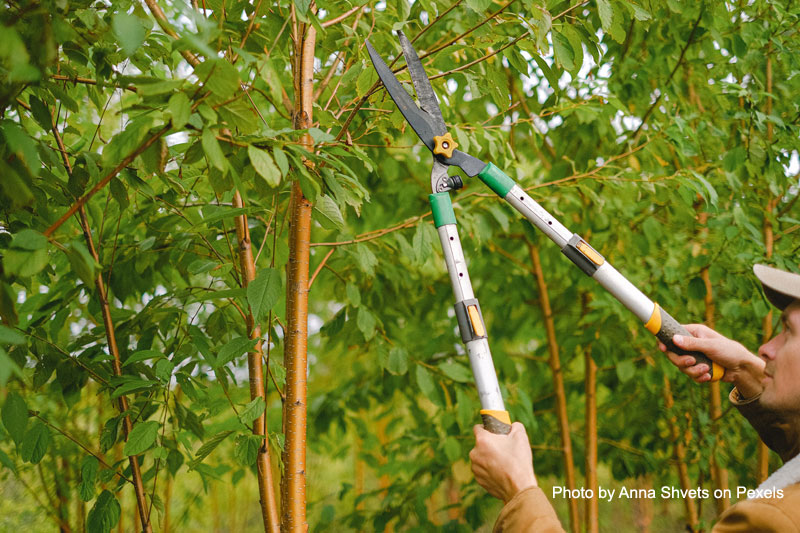Keeping your trees and shrubs pruned is one of the best ways to keep your yard looking beautiful and healthy. Regular pruning also promotes the new growth of your trees. This guide is a starting point for those who want to understand how trimming and pruning your trees benefits them and why you should work with an ISA Certified Arborist.
The Benefits of Trimming and Pruning
While all trees will continue to grow without pruning or trimming, there are still many benefits to this type of upkeep, such as:
- Regular pruning lowers the risk of pest infestation, decay, and some tree diseases.
- Pruning ensures your tree will get better light, which can boost its growth.
- Trimming trees can help you control their size.
- Pruning may promote the fruition and flowering of some trees.
- Regular trimming can reduce safety hazards, such as when tree limbs get too close to power lines or are low enough to cause other safety concerns.
- Trimming can improve your view in some instances.
What to Prune or Trim From a Tree
Your ISA Certified Arborist can determine what type of trimming and pruning your trees need. It’s usually best to trim trees between mid-winter and the end of winter when the trees are dormant. Pruning during this time lets you assess damaged limbs better and encourages growth once spring arrives.
Assessing the tree to be pruned is vital. There are several things to look for that should be removed, such as:
- Dead, dying, broken, or diseased branches: Any branches that are dead, dying, diseased, or broken should be pruned. These damaged branches can be removed at any time of the year since they risk the tree’s health. Pruning these branches prevents the tree from wasting precious energy on damaged areas. In the case of disease, the sooner the branch is removed, the less risk the disease will spread to other areas of the tree. In both instances, pruning the tree ensures it can focus on new, healthy growth.
- Branches growing in the wrong direction: When assessing your trees, you may encounter some with branches that extend across one another, which is a risk for chafing, creating an access point for insects and disease. Additionally, branches that grow inward create the same problem of potential chafing. This scenario can put the tree at greater risk of rot or fungal disease. Branches that grow downward can come into contact with the ground or other plants, exposing them to pests and disease. These low branches can also be a safety risk for humans and pets and should be removed.
- Suckers and water sprouts: Suckers grow out of the tree’s base from its roots and are an energy drain on trees. Water sprouts grow straight up from the main branches of trees and shrubs. They should be removed as soon as you see them to help guide the plan’s shape and growth and prevent overlapping chafing.
Once you have removed the immediate threats to the tree, you can begin to prune them to promote health and new growth.
Young trees and shrubs should be pruned in a balanced way that promotes an open structure of the branches. Any crossed branches or inward-growing stems should be removed before they grow large enough to be an issue. You can also look for branches growing at less than a thirty-degree angle in relation to the trunk since these are more likely to break off during storms. Older trees and shrubs often benefit more from pruning, as it can encourage them to produce new growth.
How to Prune or Trim a Tree
Using the proper technique when pruning or tree trimming is essential, as it can minimize the risk of disease or pest problems at the trim’s site. Your ISA Certified Arborist can be sure that the right tools and techniques are used to keep your trees healthy. Here is some of what proper tree trimming involves.
- Locate the branch collar or the area where the branch comes out of the tree. It is often marked with a ridge, a circle, or an area where the bark is thicker. Make the cur directly outside of the branch collar. If you damage the tree on the branch collar, it won’t be able to form a good callus and may cause rot later.
- Make your cuts at a downward angle so that water cannot settle in the wound.
- Do not trim branches growing straight upward.
- Do not leave too much of the branch present when you trim, as this also makes it hard to form a callus.
While this guide offers the fundamentals of pruning or trimming a tree, it is also a good idea to consult with an ISA Certified Arborist before making any cuts. These professionals can ensure that the right branches are trimmed at the best location. Contact Tree Barber today for more information about tree trimming and pruning.
Recognized as a top tree care company, Tree Barber Enterprises serves thousands of residential and business customers in North County San Diego. Our ISA Certified Arborist, Paul Rider #WE-1087A, and Certified Tree Workers are highly skilled and extensively trained in the latest arboriculture techniques, which enables us to perform our tasks quickly, safely, and economically.

